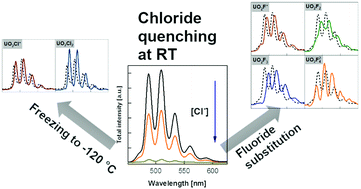Temperature-dependent luminescence spectroscopic investigations of uranyl(vi) complexation with the halides F− and Cl−†
Abstract
In the present study we have investigated the complexation of uranyl(VI) with chloride and fluoride using luminescence spectroscopy (TRLFS, time-resolved laser-induced fluorescence spectroscopy). At 25 °C (298.15 K), in the presence of 0–0.175 M fluoride, the first single-component emission spectra for all four uranyl(VI)-fluoride complexes, i.e. UO2F+, UO2F2, UO2F3−, and UO2F42− could be extracted. Based on the aqueous speciation derived from the TRLFS data, log K* values at I = 1 M were calculated for all these complexes and extrapolated to infinite dilution using the SIT approach. In the case of chloride, however, quenching of the uranyl(VI)-luminescence hampered the experiments. Thus, uranyl(VI)-complexation was studied with TRLFS at liquid nitrogen temperatures. Samples were prepared at 25 °C (298.15 K) with chloride concentrations ranging from 0 to 1.0 M followed by instantaneous freezing and subsequent luminescence spectroscopic measurements at −120 °C (153.15 K). This allowed for the determination of the first luminescence spectra for the UO2Cl+ complex with the TRLFS method. The chloride quench reaction was further studied in the temperature range 1–45 °C (274.15–318.15 K) using Stern–Volmer analysis. By applying the Arrhenius and the Eyring equations we obtained the first thermodynamic parameters for the dynamic quench process, i.e. the activation energy (Ea = 55.0 ± 12.9 kJ mol−1), enthalpy (ΔH‡ = 52.5 ± 13.0 kJ mol−1), and entropy (ΔS‡ = 103.9 ± 42.8 J mol−1 K−1).



 Please wait while we load your content...
Please wait while we load your content...